Victoria University: Farm House Gold Milk Marketing Plan for China
VerifiedAdded on 2023/03/23
|17
|4437
|69
Report
AI Summary
This report presents a comprehensive marketing plan for the introduction of Farm House Gold Milk into the Chinese market. It begins with an executive summary and an introduction to the brand, emphasizing its Australian origin and reputation. The report justifies the selection of China based on geographic, economic, political/legal, and technological factors, alongside an identification of the competitive landscape. A significant portion of the report is dedicated to a cultural profile of China, analyzed through Hofstede's cultural dimensions, and comparing it with Australian culture. Further sections cover country-of-origin effects, market segmentation based on demographics, geographics, psychographics, and behavioral patterns, and target market identification. The report also details positioning strategies and market entry and expansion strategies, including strategic recommendations for product modification, distribution, pricing, and culturally adapted promotion. The conclusion summarizes the key findings and recommendations for successful market entry.

FINAL GROUP REPORT
MARKETING PLAN
FARMHOUSE GOLD MILK, CHINA.
1
MARKETING PLAN
FARMHOUSE GOLD MILK, CHINA.
1
Paraphrase This Document
Need a fresh take? Get an instant paraphrase of this document with our AI Paraphraser
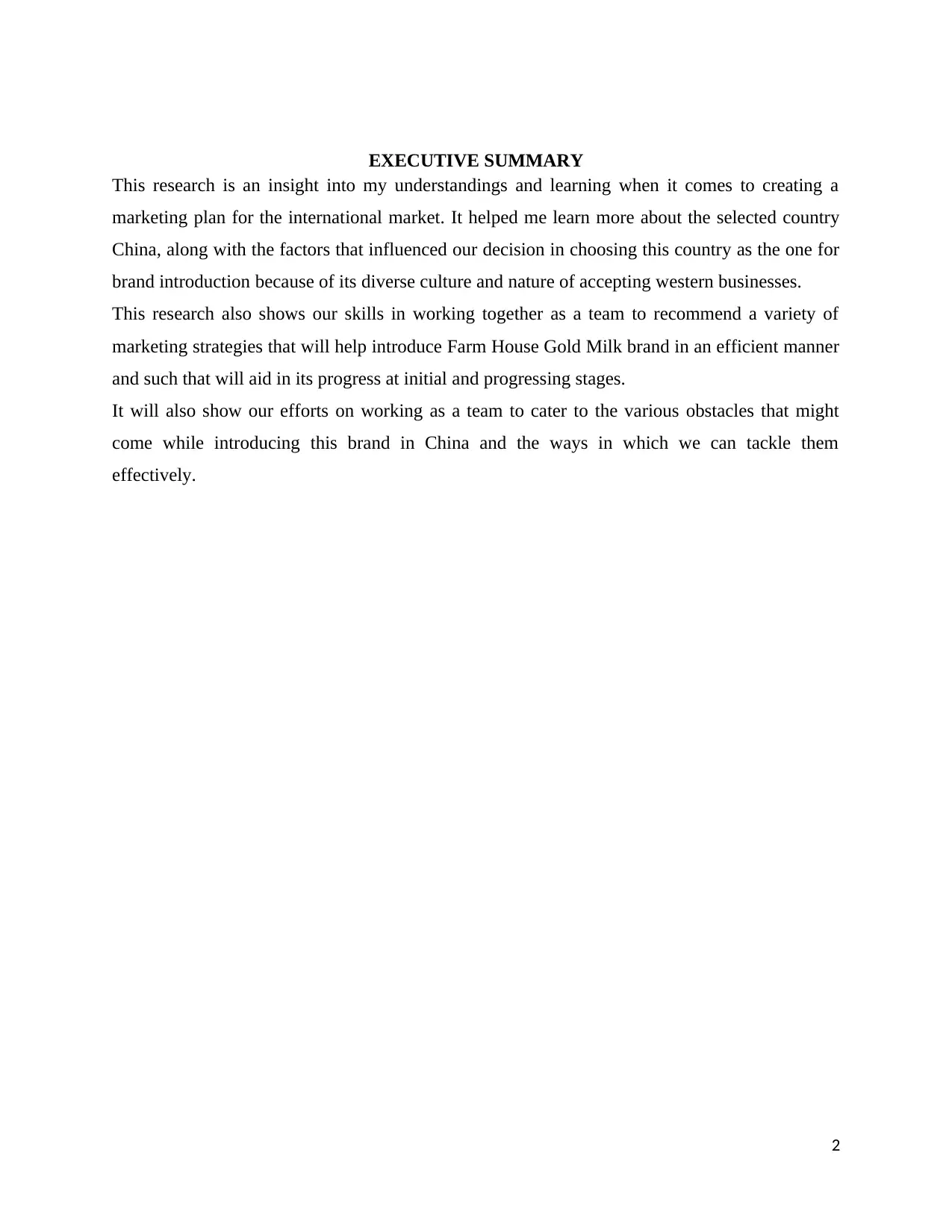
EXECUTIVE SUMMARY
This research is an insight into my understandings and learning when it comes to creating a
marketing plan for the international market. It helped me learn more about the selected country
China, along with the factors that influenced our decision in choosing this country as the one for
brand introduction because of its diverse culture and nature of accepting western businesses.
This research also shows our skills in working together as a team to recommend a variety of
marketing strategies that will help introduce Farm House Gold Milk brand in an efficient manner
and such that will aid in its progress at initial and progressing stages.
It will also show our efforts on working as a team to cater to the various obstacles that might
come while introducing this brand in China and the ways in which we can tackle them
effectively.
2
This research is an insight into my understandings and learning when it comes to creating a
marketing plan for the international market. It helped me learn more about the selected country
China, along with the factors that influenced our decision in choosing this country as the one for
brand introduction because of its diverse culture and nature of accepting western businesses.
This research also shows our skills in working together as a team to recommend a variety of
marketing strategies that will help introduce Farm House Gold Milk brand in an efficient manner
and such that will aid in its progress at initial and progressing stages.
It will also show our efforts on working as a team to cater to the various obstacles that might
come while introducing this brand in China and the ways in which we can tackle them
effectively.
2
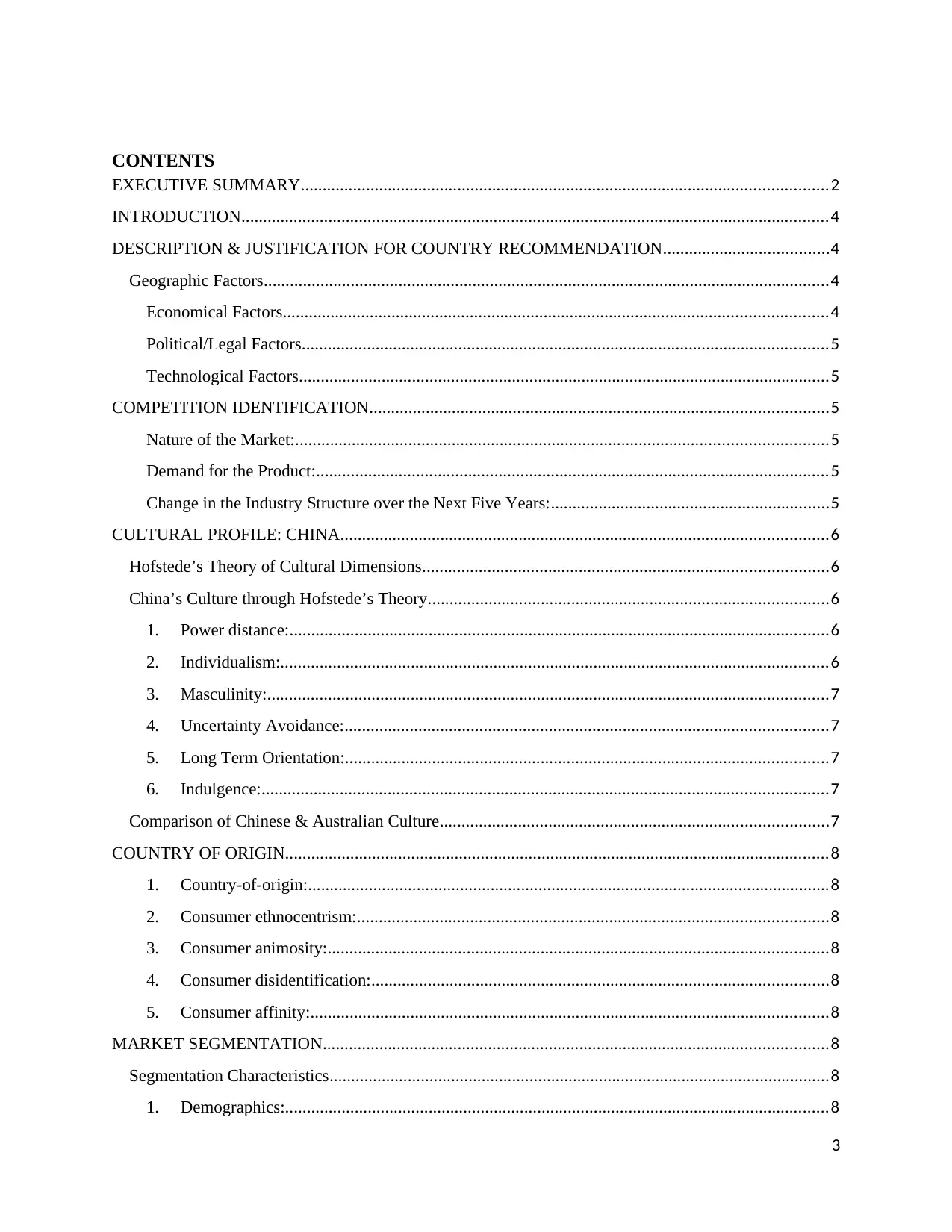
CONTENTS
EXECUTIVE SUMMARY.........................................................................................................................2
INTRODUCTION.......................................................................................................................................4
DESCRIPTION & JUSTIFICATION FOR COUNTRY RECOMMENDATION......................................4
Geographic Factors..................................................................................................................................4
Economical Factors.............................................................................................................................4
Political/Legal Factors.........................................................................................................................5
Technological Factors..........................................................................................................................5
COMPETITION IDENTIFICATION.........................................................................................................5
Nature of the Market:..........................................................................................................................5
Demand for the Product:......................................................................................................................5
Change in the Industry Structure over the Next Five Years:................................................................5
CULTURAL PROFILE: CHINA................................................................................................................6
Hofstede’s Theory of Cultural Dimensions.............................................................................................6
China’s Culture through Hofstede’s Theory............................................................................................6
1. Power distance:............................................................................................................................6
2. Individualism:..............................................................................................................................6
3. Masculinity:.................................................................................................................................7
4. Uncertainty Avoidance:...............................................................................................................7
5. Long Term Orientation:...............................................................................................................7
6. Indulgence:..................................................................................................................................7
Comparison of Chinese & Australian Culture.........................................................................................7
COUNTRY OF ORIGIN.............................................................................................................................8
1. Country-of-origin:........................................................................................................................8
2. Consumer ethnocentrism:............................................................................................................8
3. Consumer animosity:...................................................................................................................8
4. Consumer disidentification:.........................................................................................................8
5. Consumer affinity:.......................................................................................................................8
MARKET SEGMENTATION....................................................................................................................8
Segmentation Characteristics...................................................................................................................8
1. Demographics:.............................................................................................................................8
3
EXECUTIVE SUMMARY.........................................................................................................................2
INTRODUCTION.......................................................................................................................................4
DESCRIPTION & JUSTIFICATION FOR COUNTRY RECOMMENDATION......................................4
Geographic Factors..................................................................................................................................4
Economical Factors.............................................................................................................................4
Political/Legal Factors.........................................................................................................................5
Technological Factors..........................................................................................................................5
COMPETITION IDENTIFICATION.........................................................................................................5
Nature of the Market:..........................................................................................................................5
Demand for the Product:......................................................................................................................5
Change in the Industry Structure over the Next Five Years:................................................................5
CULTURAL PROFILE: CHINA................................................................................................................6
Hofstede’s Theory of Cultural Dimensions.............................................................................................6
China’s Culture through Hofstede’s Theory............................................................................................6
1. Power distance:............................................................................................................................6
2. Individualism:..............................................................................................................................6
3. Masculinity:.................................................................................................................................7
4. Uncertainty Avoidance:...............................................................................................................7
5. Long Term Orientation:...............................................................................................................7
6. Indulgence:..................................................................................................................................7
Comparison of Chinese & Australian Culture.........................................................................................7
COUNTRY OF ORIGIN.............................................................................................................................8
1. Country-of-origin:........................................................................................................................8
2. Consumer ethnocentrism:............................................................................................................8
3. Consumer animosity:...................................................................................................................8
4. Consumer disidentification:.........................................................................................................8
5. Consumer affinity:.......................................................................................................................8
MARKET SEGMENTATION....................................................................................................................8
Segmentation Characteristics...................................................................................................................8
1. Demographics:.............................................................................................................................8
3
⊘ This is a preview!⊘
Do you want full access?
Subscribe today to unlock all pages.

Trusted by 1+ million students worldwide
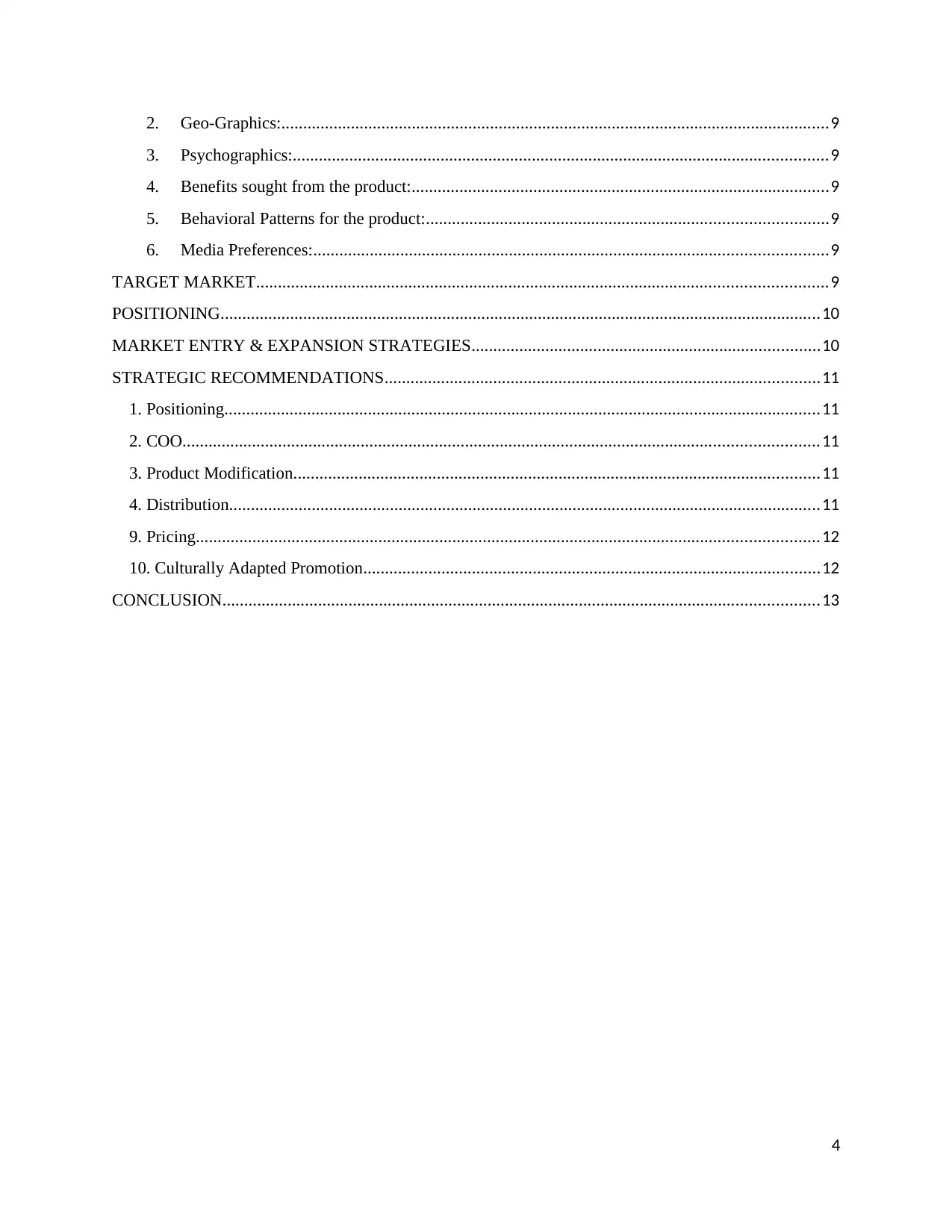
2. Geo-Graphics:..............................................................................................................................9
3. Psychographics:...........................................................................................................................9
4. Benefits sought from the product:................................................................................................9
5. Behavioral Patterns for the product:............................................................................................9
6. Media Preferences:......................................................................................................................9
TARGET MARKET...................................................................................................................................9
POSITIONING..........................................................................................................................................10
MARKET ENTRY & EXPANSION STRATEGIES................................................................................10
STRATEGIC RECOMMENDATIONS....................................................................................................11
1. Positioning.........................................................................................................................................11
2. COO..................................................................................................................................................11
3. Product Modification.........................................................................................................................11
4. Distribution........................................................................................................................................11
9. Pricing...............................................................................................................................................12
10. Culturally Adapted Promotion.........................................................................................................12
CONCLUSION.........................................................................................................................................13
4
3. Psychographics:...........................................................................................................................9
4. Benefits sought from the product:................................................................................................9
5. Behavioral Patterns for the product:............................................................................................9
6. Media Preferences:......................................................................................................................9
TARGET MARKET...................................................................................................................................9
POSITIONING..........................................................................................................................................10
MARKET ENTRY & EXPANSION STRATEGIES................................................................................10
STRATEGIC RECOMMENDATIONS....................................................................................................11
1. Positioning.........................................................................................................................................11
2. COO..................................................................................................................................................11
3. Product Modification.........................................................................................................................11
4. Distribution........................................................................................................................................11
9. Pricing...............................................................................................................................................12
10. Culturally Adapted Promotion.........................................................................................................12
CONCLUSION.........................................................................................................................................13
4
Paraphrase This Document
Need a fresh take? Get an instant paraphrase of this document with our AI Paraphraser

INTRODUCTION
This research is an insight into the marketing plan created for the Australian household
Dairy brand Farm House Gold Milk under Paul's, Australia, for its international market entrance
in China. The brand has a variety of dairy products that are organic and trusted by the Australian
nation for a long time. They have the policy of making great tasting products that resonate with
the daily requirements of the people, along with having the best of the nutritional values and
requirements in them. It is Australia's Number 1 Dairy brand. They provide different ranges of
Milk from Full cream to Skinny Milk and more. Other products include a range of custards,
yogurts, creams, desserts, sour creams, and flavored milk, among many (Pauls, 2019).
The selected country for this international marketing plan in China and the reason for this
is because this country has a low rate of dairy production and there is more scope of this industry
because of the growing dairy requirements in both urban and rural areas of China (Fuller and
Beghin, 2015). Other factors that influence this decision include the favorable market that uses
methods of advertising that Australians are familiar with and the growing concern in the Chinese
community for CSR and environment welfare related products (Yang and He, 2011).
DESCRIPTION & JUSTIFICATION FOR COUNTRY RECOMMENDATION
Geographic Factors
A distinct geographic print includes physical and environmental features such as climate,
soils, topography, and location. The geography of China is represented through the following
nine major factors that include The North China Plain, The Loess Plateau, The Southeast Coast
& Shanghai, The Yangzi Valley, The Sichuan Basin, Southwest Uplands, Xinjiang, Northeast
(Manchuria), along with Qinghai & The Tibetan Plateau. For a politically stable China, it is
important to tie all these different regions together. Through the means of tying the country and
its regions together, shared cultural values and a common language was evaluated (Asia Society,
2019).
Economical Factors
Since the year 2000, China has not only begun with the highest economic growths but
also one of the highest rates of income inequality in the world. A relatively new phenomenon in
China's last half-century is Regional income inequality. Investment in Human capital at the level
5
This research is an insight into the marketing plan created for the Australian household
Dairy brand Farm House Gold Milk under Paul's, Australia, for its international market entrance
in China. The brand has a variety of dairy products that are organic and trusted by the Australian
nation for a long time. They have the policy of making great tasting products that resonate with
the daily requirements of the people, along with having the best of the nutritional values and
requirements in them. It is Australia's Number 1 Dairy brand. They provide different ranges of
Milk from Full cream to Skinny Milk and more. Other products include a range of custards,
yogurts, creams, desserts, sour creams, and flavored milk, among many (Pauls, 2019).
The selected country for this international marketing plan in China and the reason for this
is because this country has a low rate of dairy production and there is more scope of this industry
because of the growing dairy requirements in both urban and rural areas of China (Fuller and
Beghin, 2015). Other factors that influence this decision include the favorable market that uses
methods of advertising that Australians are familiar with and the growing concern in the Chinese
community for CSR and environment welfare related products (Yang and He, 2011).
DESCRIPTION & JUSTIFICATION FOR COUNTRY RECOMMENDATION
Geographic Factors
A distinct geographic print includes physical and environmental features such as climate,
soils, topography, and location. The geography of China is represented through the following
nine major factors that include The North China Plain, The Loess Plateau, The Southeast Coast
& Shanghai, The Yangzi Valley, The Sichuan Basin, Southwest Uplands, Xinjiang, Northeast
(Manchuria), along with Qinghai & The Tibetan Plateau. For a politically stable China, it is
important to tie all these different regions together. Through the means of tying the country and
its regions together, shared cultural values and a common language was evaluated (Asia Society,
2019).
Economical Factors
Since the year 2000, China has not only begun with the highest economic growths but
also one of the highest rates of income inequality in the world. A relatively new phenomenon in
China's last half-century is Regional income inequality. Investment in Human capital at the level
5
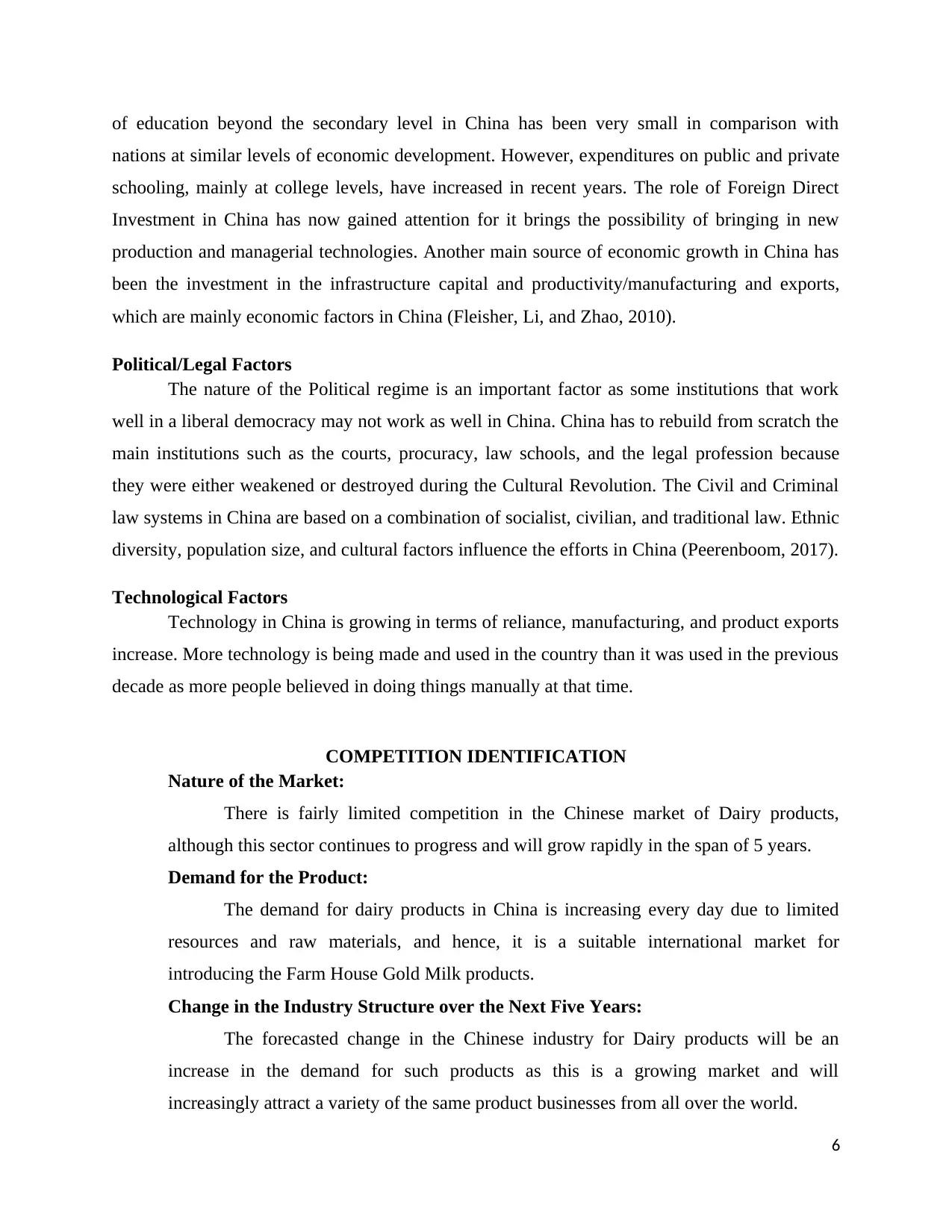
of education beyond the secondary level in China has been very small in comparison with
nations at similar levels of economic development. However, expenditures on public and private
schooling, mainly at college levels, have increased in recent years. The role of Foreign Direct
Investment in China has now gained attention for it brings the possibility of bringing in new
production and managerial technologies. Another main source of economic growth in China has
been the investment in the infrastructure capital and productivity/manufacturing and exports,
which are mainly economic factors in China (Fleisher, Li, and Zhao, 2010).
Political/Legal Factors
The nature of the Political regime is an important factor as some institutions that work
well in a liberal democracy may not work as well in China. China has to rebuild from scratch the
main institutions such as the courts, procuracy, law schools, and the legal profession because
they were either weakened or destroyed during the Cultural Revolution. The Civil and Criminal
law systems in China are based on a combination of socialist, civilian, and traditional law. Ethnic
diversity, population size, and cultural factors influence the efforts in China (Peerenboom, 2017).
Technological Factors
Technology in China is growing in terms of reliance, manufacturing, and product exports
increase. More technology is being made and used in the country than it was used in the previous
decade as more people believed in doing things manually at that time.
COMPETITION IDENTIFICATION
Nature of the Market:
There is fairly limited competition in the Chinese market of Dairy products,
although this sector continues to progress and will grow rapidly in the span of 5 years.
Demand for the Product:
The demand for dairy products in China is increasing every day due to limited
resources and raw materials, and hence, it is a suitable international market for
introducing the Farm House Gold Milk products.
Change in the Industry Structure over the Next Five Years:
The forecasted change in the Chinese industry for Dairy products will be an
increase in the demand for such products as this is a growing market and will
increasingly attract a variety of the same product businesses from all over the world.
6
nations at similar levels of economic development. However, expenditures on public and private
schooling, mainly at college levels, have increased in recent years. The role of Foreign Direct
Investment in China has now gained attention for it brings the possibility of bringing in new
production and managerial technologies. Another main source of economic growth in China has
been the investment in the infrastructure capital and productivity/manufacturing and exports,
which are mainly economic factors in China (Fleisher, Li, and Zhao, 2010).
Political/Legal Factors
The nature of the Political regime is an important factor as some institutions that work
well in a liberal democracy may not work as well in China. China has to rebuild from scratch the
main institutions such as the courts, procuracy, law schools, and the legal profession because
they were either weakened or destroyed during the Cultural Revolution. The Civil and Criminal
law systems in China are based on a combination of socialist, civilian, and traditional law. Ethnic
diversity, population size, and cultural factors influence the efforts in China (Peerenboom, 2017).
Technological Factors
Technology in China is growing in terms of reliance, manufacturing, and product exports
increase. More technology is being made and used in the country than it was used in the previous
decade as more people believed in doing things manually at that time.
COMPETITION IDENTIFICATION
Nature of the Market:
There is fairly limited competition in the Chinese market of Dairy products,
although this sector continues to progress and will grow rapidly in the span of 5 years.
Demand for the Product:
The demand for dairy products in China is increasing every day due to limited
resources and raw materials, and hence, it is a suitable international market for
introducing the Farm House Gold Milk products.
Change in the Industry Structure over the Next Five Years:
The forecasted change in the Chinese industry for Dairy products will be an
increase in the demand for such products as this is a growing market and will
increasingly attract a variety of the same product businesses from all over the world.
6
⊘ This is a preview!⊘
Do you want full access?
Subscribe today to unlock all pages.

Trusted by 1+ million students worldwide
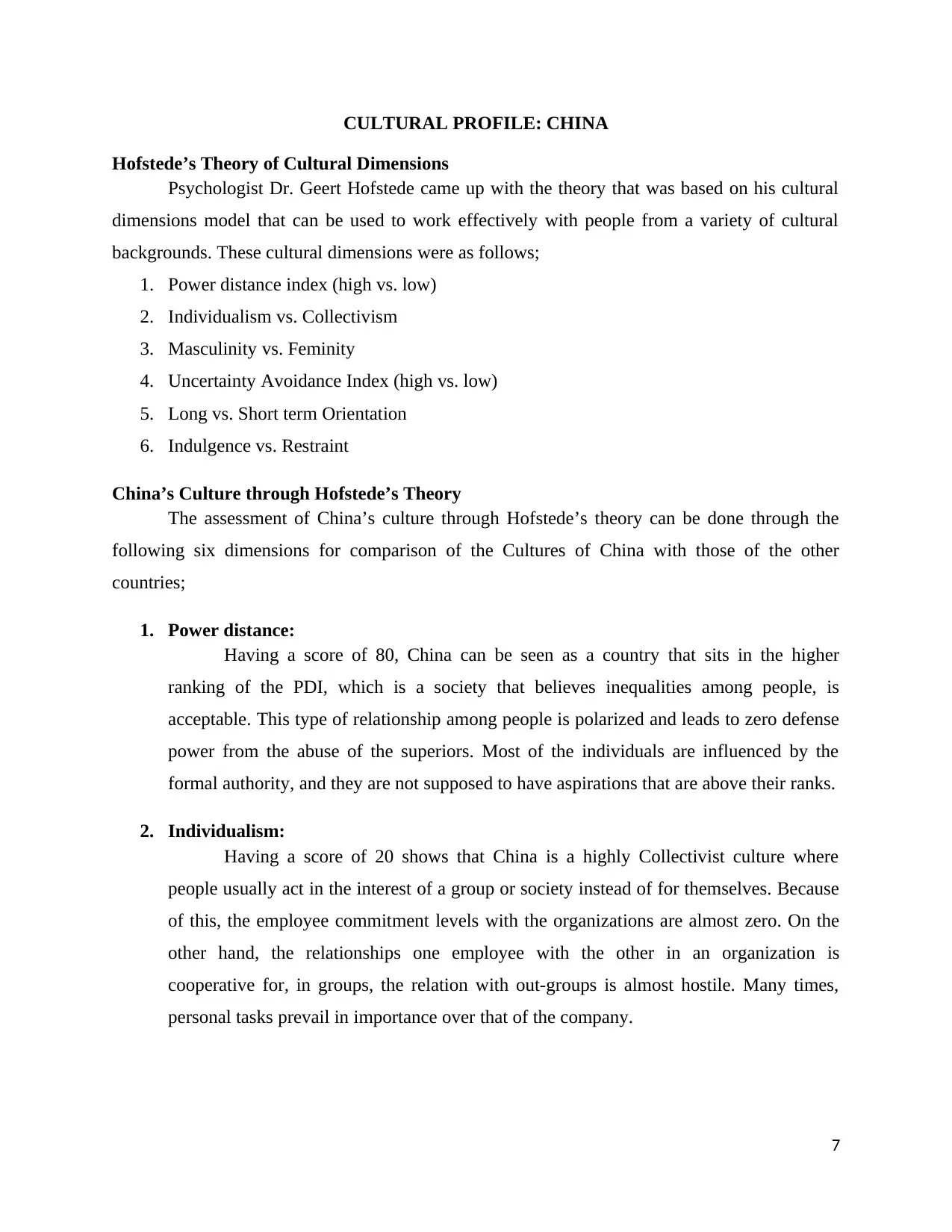
CULTURAL PROFILE: CHINA
Hofstede’s Theory of Cultural Dimensions
Psychologist Dr. Geert Hofstede came up with the theory that was based on his cultural
dimensions model that can be used to work effectively with people from a variety of cultural
backgrounds. These cultural dimensions were as follows;
1. Power distance index (high vs. low)
2. Individualism vs. Collectivism
3. Masculinity vs. Feminity
4. Uncertainty Avoidance Index (high vs. low)
5. Long vs. Short term Orientation
6. Indulgence vs. Restraint
China’s Culture through Hofstede’s Theory
The assessment of China’s culture through Hofstede’s theory can be done through the
following six dimensions for comparison of the Cultures of China with those of the other
countries;
1. Power distance:
Having a score of 80, China can be seen as a country that sits in the higher
ranking of the PDI, which is a society that believes inequalities among people, is
acceptable. This type of relationship among people is polarized and leads to zero defense
power from the abuse of the superiors. Most of the individuals are influenced by the
formal authority, and they are not supposed to have aspirations that are above their ranks.
2. Individualism:
Having a score of 20 shows that China is a highly Collectivist culture where
people usually act in the interest of a group or society instead of for themselves. Because
of this, the employee commitment levels with the organizations are almost zero. On the
other hand, the relationships one employee with the other in an organization is
cooperative for, in groups, the relation with out-groups is almost hostile. Many times,
personal tasks prevail in importance over that of the company.
7
Hofstede’s Theory of Cultural Dimensions
Psychologist Dr. Geert Hofstede came up with the theory that was based on his cultural
dimensions model that can be used to work effectively with people from a variety of cultural
backgrounds. These cultural dimensions were as follows;
1. Power distance index (high vs. low)
2. Individualism vs. Collectivism
3. Masculinity vs. Feminity
4. Uncertainty Avoidance Index (high vs. low)
5. Long vs. Short term Orientation
6. Indulgence vs. Restraint
China’s Culture through Hofstede’s Theory
The assessment of China’s culture through Hofstede’s theory can be done through the
following six dimensions for comparison of the Cultures of China with those of the other
countries;
1. Power distance:
Having a score of 80, China can be seen as a country that sits in the higher
ranking of the PDI, which is a society that believes inequalities among people, is
acceptable. This type of relationship among people is polarized and leads to zero defense
power from the abuse of the superiors. Most of the individuals are influenced by the
formal authority, and they are not supposed to have aspirations that are above their ranks.
2. Individualism:
Having a score of 20 shows that China is a highly Collectivist culture where
people usually act in the interest of a group or society instead of for themselves. Because
of this, the employee commitment levels with the organizations are almost zero. On the
other hand, the relationships one employee with the other in an organization is
cooperative for, in groups, the relation with out-groups is almost hostile. Many times,
personal tasks prevail in importance over that of the company.
7
Paraphrase This Document
Need a fresh take? Get an instant paraphrase of this document with our AI Paraphraser
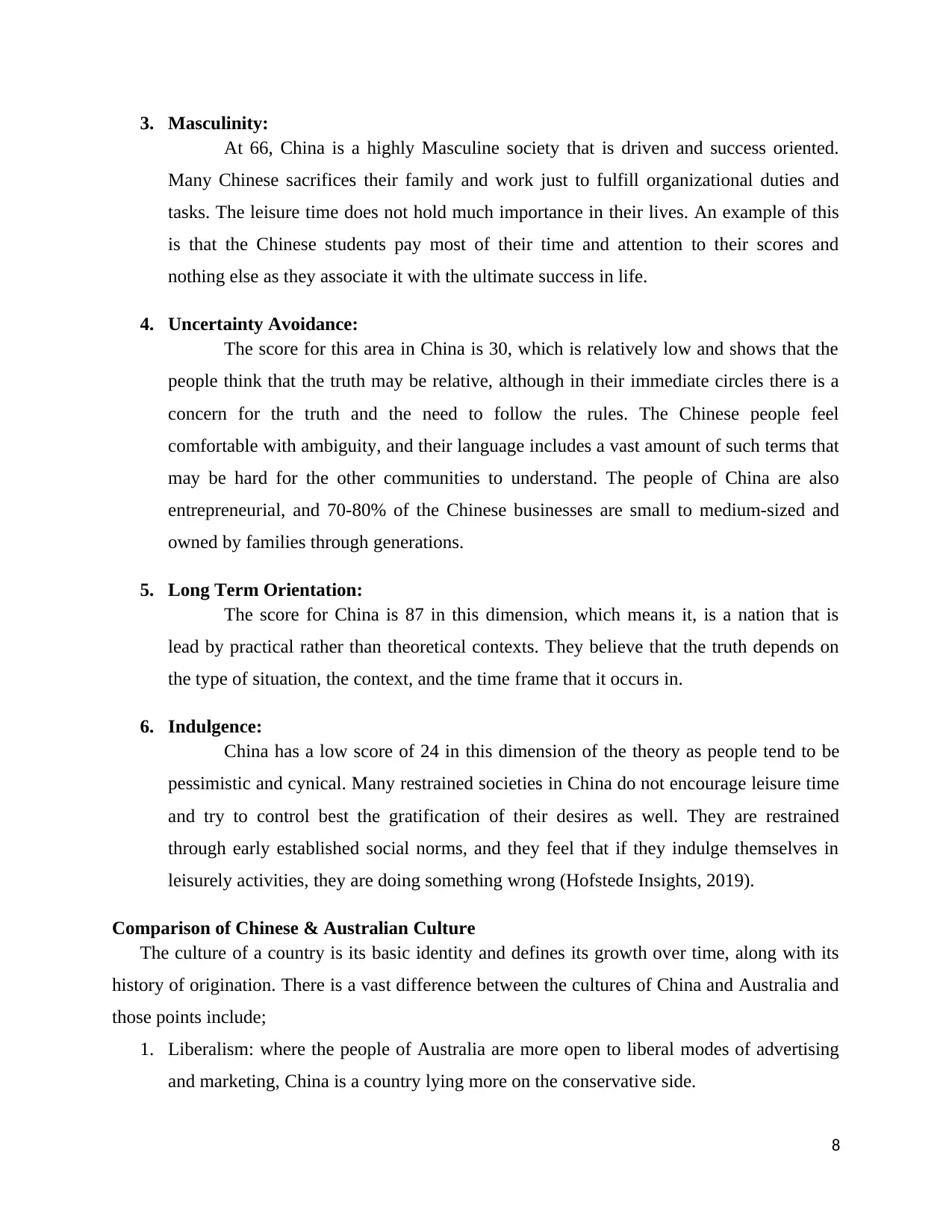
3. Masculinity:
At 66, China is a highly Masculine society that is driven and success oriented.
Many Chinese sacrifices their family and work just to fulfill organizational duties and
tasks. The leisure time does not hold much importance in their lives. An example of this
is that the Chinese students pay most of their time and attention to their scores and
nothing else as they associate it with the ultimate success in life.
4. Uncertainty Avoidance:
The score for this area in China is 30, which is relatively low and shows that the
people think that the truth may be relative, although in their immediate circles there is a
concern for the truth and the need to follow the rules. The Chinese people feel
comfortable with ambiguity, and their language includes a vast amount of such terms that
may be hard for the other communities to understand. The people of China are also
entrepreneurial, and 70-80% of the Chinese businesses are small to medium-sized and
owned by families through generations.
5. Long Term Orientation:
The score for China is 87 in this dimension, which means it, is a nation that is
lead by practical rather than theoretical contexts. They believe that the truth depends on
the type of situation, the context, and the time frame that it occurs in.
6. Indulgence:
China has a low score of 24 in this dimension of the theory as people tend to be
pessimistic and cynical. Many restrained societies in China do not encourage leisure time
and try to control best the gratification of their desires as well. They are restrained
through early established social norms, and they feel that if they indulge themselves in
leisurely activities, they are doing something wrong (Hofstede Insights, 2019).
Comparison of Chinese & Australian Culture
The culture of a country is its basic identity and defines its growth over time, along with its
history of origination. There is a vast difference between the cultures of China and Australia and
those points include;
1. Liberalism: where the people of Australia are more open to liberal modes of advertising
and marketing, China is a country lying more on the conservative side.
8
At 66, China is a highly Masculine society that is driven and success oriented.
Many Chinese sacrifices their family and work just to fulfill organizational duties and
tasks. The leisure time does not hold much importance in their lives. An example of this
is that the Chinese students pay most of their time and attention to their scores and
nothing else as they associate it with the ultimate success in life.
4. Uncertainty Avoidance:
The score for this area in China is 30, which is relatively low and shows that the
people think that the truth may be relative, although in their immediate circles there is a
concern for the truth and the need to follow the rules. The Chinese people feel
comfortable with ambiguity, and their language includes a vast amount of such terms that
may be hard for the other communities to understand. The people of China are also
entrepreneurial, and 70-80% of the Chinese businesses are small to medium-sized and
owned by families through generations.
5. Long Term Orientation:
The score for China is 87 in this dimension, which means it, is a nation that is
lead by practical rather than theoretical contexts. They believe that the truth depends on
the type of situation, the context, and the time frame that it occurs in.
6. Indulgence:
China has a low score of 24 in this dimension of the theory as people tend to be
pessimistic and cynical. Many restrained societies in China do not encourage leisure time
and try to control best the gratification of their desires as well. They are restrained
through early established social norms, and they feel that if they indulge themselves in
leisurely activities, they are doing something wrong (Hofstede Insights, 2019).
Comparison of Chinese & Australian Culture
The culture of a country is its basic identity and defines its growth over time, along with its
history of origination. There is a vast difference between the cultures of China and Australia and
those points include;
1. Liberalism: where the people of Australia are more open to liberal modes of advertising
and marketing, China is a country lying more on the conservative side.
8
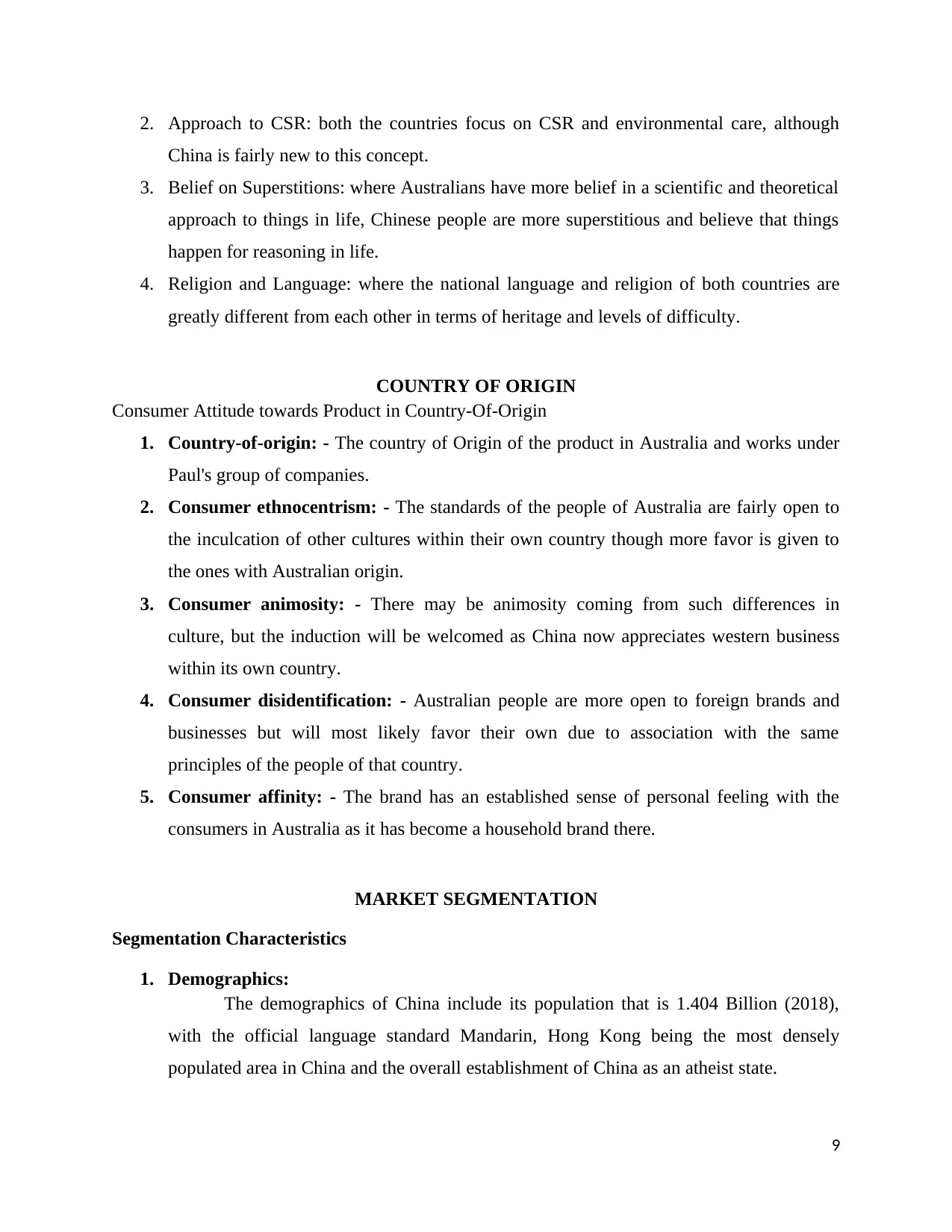
2. Approach to CSR: both the countries focus on CSR and environmental care, although
China is fairly new to this concept.
3. Belief on Superstitions: where Australians have more belief in a scientific and theoretical
approach to things in life, Chinese people are more superstitious and believe that things
happen for reasoning in life.
4. Religion and Language: where the national language and religion of both countries are
greatly different from each other in terms of heritage and levels of difficulty.
COUNTRY OF ORIGIN
Consumer Attitude towards Product in Country-Of-Origin
1. Country-of-origin: - The country of Origin of the product in Australia and works under
Paul's group of companies.
2. Consumer ethnocentrism: - The standards of the people of Australia are fairly open to
the inculcation of other cultures within their own country though more favor is given to
the ones with Australian origin.
3. Consumer animosity: - There may be animosity coming from such differences in
culture, but the induction will be welcomed as China now appreciates western business
within its own country.
4. Consumer disidentification: - Australian people are more open to foreign brands and
businesses but will most likely favor their own due to association with the same
principles of the people of that country.
5. Consumer affinity: - The brand has an established sense of personal feeling with the
consumers in Australia as it has become a household brand there.
MARKET SEGMENTATION
Segmentation Characteristics
1. Demographics:
The demographics of China include its population that is 1.404 Billion (2018),
with the official language standard Mandarin, Hong Kong being the most densely
populated area in China and the overall establishment of China as an atheist state.
9
China is fairly new to this concept.
3. Belief on Superstitions: where Australians have more belief in a scientific and theoretical
approach to things in life, Chinese people are more superstitious and believe that things
happen for reasoning in life.
4. Religion and Language: where the national language and religion of both countries are
greatly different from each other in terms of heritage and levels of difficulty.
COUNTRY OF ORIGIN
Consumer Attitude towards Product in Country-Of-Origin
1. Country-of-origin: - The country of Origin of the product in Australia and works under
Paul's group of companies.
2. Consumer ethnocentrism: - The standards of the people of Australia are fairly open to
the inculcation of other cultures within their own country though more favor is given to
the ones with Australian origin.
3. Consumer animosity: - There may be animosity coming from such differences in
culture, but the induction will be welcomed as China now appreciates western business
within its own country.
4. Consumer disidentification: - Australian people are more open to foreign brands and
businesses but will most likely favor their own due to association with the same
principles of the people of that country.
5. Consumer affinity: - The brand has an established sense of personal feeling with the
consumers in Australia as it has become a household brand there.
MARKET SEGMENTATION
Segmentation Characteristics
1. Demographics:
The demographics of China include its population that is 1.404 Billion (2018),
with the official language standard Mandarin, Hong Kong being the most densely
populated area in China and the overall establishment of China as an atheist state.
9
⊘ This is a preview!⊘
Do you want full access?
Subscribe today to unlock all pages.

Trusted by 1+ million students worldwide
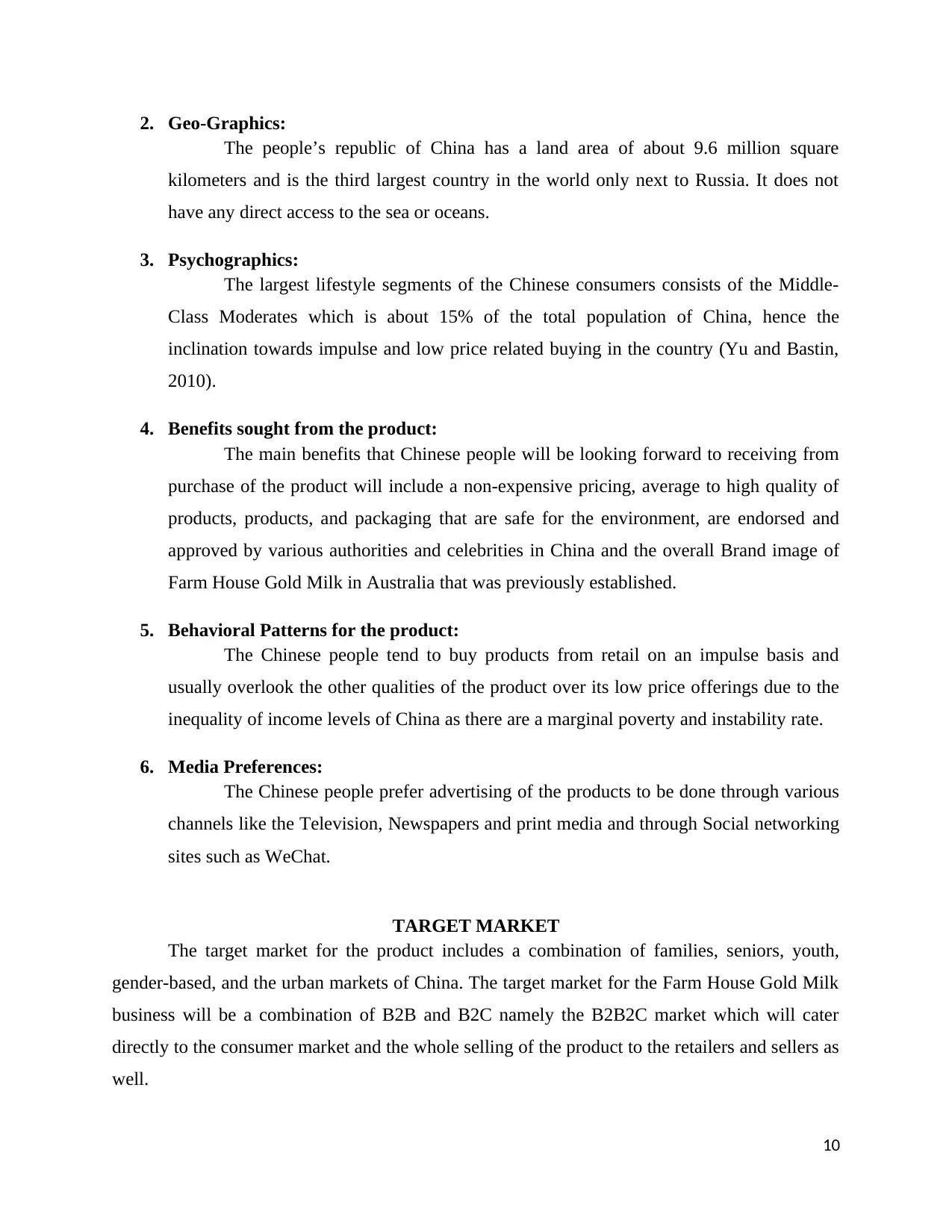
2. Geo-Graphics:
The people’s republic of China has a land area of about 9.6 million square
kilometers and is the third largest country in the world only next to Russia. It does not
have any direct access to the sea or oceans.
3. Psychographics:
The largest lifestyle segments of the Chinese consumers consists of the Middle-
Class Moderates which is about 15% of the total population of China, hence the
inclination towards impulse and low price related buying in the country (Yu and Bastin,
2010).
4. Benefits sought from the product:
The main benefits that Chinese people will be looking forward to receiving from
purchase of the product will include a non-expensive pricing, average to high quality of
products, products, and packaging that are safe for the environment, are endorsed and
approved by various authorities and celebrities in China and the overall Brand image of
Farm House Gold Milk in Australia that was previously established.
5. Behavioral Patterns for the product:
The Chinese people tend to buy products from retail on an impulse basis and
usually overlook the other qualities of the product over its low price offerings due to the
inequality of income levels of China as there are a marginal poverty and instability rate.
6. Media Preferences:
The Chinese people prefer advertising of the products to be done through various
channels like the Television, Newspapers and print media and through Social networking
sites such as WeChat.
TARGET MARKET
The target market for the product includes a combination of families, seniors, youth,
gender-based, and the urban markets of China. The target market for the Farm House Gold Milk
business will be a combination of B2B and B2C namely the B2B2C market which will cater
directly to the consumer market and the whole selling of the product to the retailers and sellers as
well.
10
The people’s republic of China has a land area of about 9.6 million square
kilometers and is the third largest country in the world only next to Russia. It does not
have any direct access to the sea or oceans.
3. Psychographics:
The largest lifestyle segments of the Chinese consumers consists of the Middle-
Class Moderates which is about 15% of the total population of China, hence the
inclination towards impulse and low price related buying in the country (Yu and Bastin,
2010).
4. Benefits sought from the product:
The main benefits that Chinese people will be looking forward to receiving from
purchase of the product will include a non-expensive pricing, average to high quality of
products, products, and packaging that are safe for the environment, are endorsed and
approved by various authorities and celebrities in China and the overall Brand image of
Farm House Gold Milk in Australia that was previously established.
5. Behavioral Patterns for the product:
The Chinese people tend to buy products from retail on an impulse basis and
usually overlook the other qualities of the product over its low price offerings due to the
inequality of income levels of China as there are a marginal poverty and instability rate.
6. Media Preferences:
The Chinese people prefer advertising of the products to be done through various
channels like the Television, Newspapers and print media and through Social networking
sites such as WeChat.
TARGET MARKET
The target market for the product includes a combination of families, seniors, youth,
gender-based, and the urban markets of China. The target market for the Farm House Gold Milk
business will be a combination of B2B and B2C namely the B2B2C market which will cater
directly to the consumer market and the whole selling of the product to the retailers and sellers as
well.
10
Paraphrase This Document
Need a fresh take? Get an instant paraphrase of this document with our AI Paraphraser
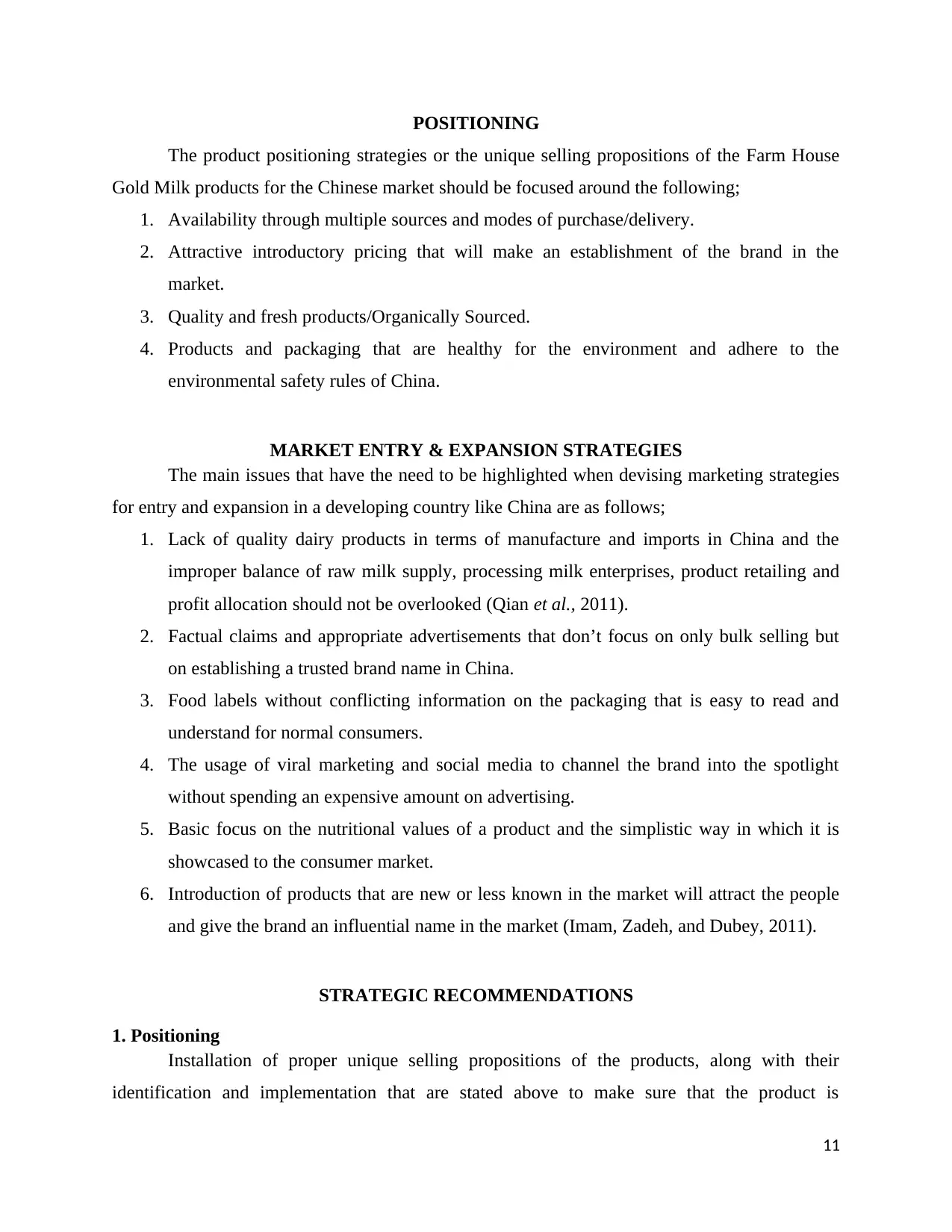
POSITIONING
The product positioning strategies or the unique selling propositions of the Farm House
Gold Milk products for the Chinese market should be focused around the following;
1. Availability through multiple sources and modes of purchase/delivery.
2. Attractive introductory pricing that will make an establishment of the brand in the
market.
3. Quality and fresh products/Organically Sourced.
4. Products and packaging that are healthy for the environment and adhere to the
environmental safety rules of China.
MARKET ENTRY & EXPANSION STRATEGIES
The main issues that have the need to be highlighted when devising marketing strategies
for entry and expansion in a developing country like China are as follows;
1. Lack of quality dairy products in terms of manufacture and imports in China and the
improper balance of raw milk supply, processing milk enterprises, product retailing and
profit allocation should not be overlooked (Qian et al., 2011).
2. Factual claims and appropriate advertisements that don’t focus on only bulk selling but
on establishing a trusted brand name in China.
3. Food labels without conflicting information on the packaging that is easy to read and
understand for normal consumers.
4. The usage of viral marketing and social media to channel the brand into the spotlight
without spending an expensive amount on advertising.
5. Basic focus on the nutritional values of a product and the simplistic way in which it is
showcased to the consumer market.
6. Introduction of products that are new or less known in the market will attract the people
and give the brand an influential name in the market (Imam, Zadeh, and Dubey, 2011).
STRATEGIC RECOMMENDATIONS
1. Positioning
Installation of proper unique selling propositions of the products, along with their
identification and implementation that are stated above to make sure that the product is
11
The product positioning strategies or the unique selling propositions of the Farm House
Gold Milk products for the Chinese market should be focused around the following;
1. Availability through multiple sources and modes of purchase/delivery.
2. Attractive introductory pricing that will make an establishment of the brand in the
market.
3. Quality and fresh products/Organically Sourced.
4. Products and packaging that are healthy for the environment and adhere to the
environmental safety rules of China.
MARKET ENTRY & EXPANSION STRATEGIES
The main issues that have the need to be highlighted when devising marketing strategies
for entry and expansion in a developing country like China are as follows;
1. Lack of quality dairy products in terms of manufacture and imports in China and the
improper balance of raw milk supply, processing milk enterprises, product retailing and
profit allocation should not be overlooked (Qian et al., 2011).
2. Factual claims and appropriate advertisements that don’t focus on only bulk selling but
on establishing a trusted brand name in China.
3. Food labels without conflicting information on the packaging that is easy to read and
understand for normal consumers.
4. The usage of viral marketing and social media to channel the brand into the spotlight
without spending an expensive amount on advertising.
5. Basic focus on the nutritional values of a product and the simplistic way in which it is
showcased to the consumer market.
6. Introduction of products that are new or less known in the market will attract the people
and give the brand an influential name in the market (Imam, Zadeh, and Dubey, 2011).
STRATEGIC RECOMMENDATIONS
1. Positioning
Installation of proper unique selling propositions of the products, along with their
identification and implementation that are stated above to make sure that the product is
11
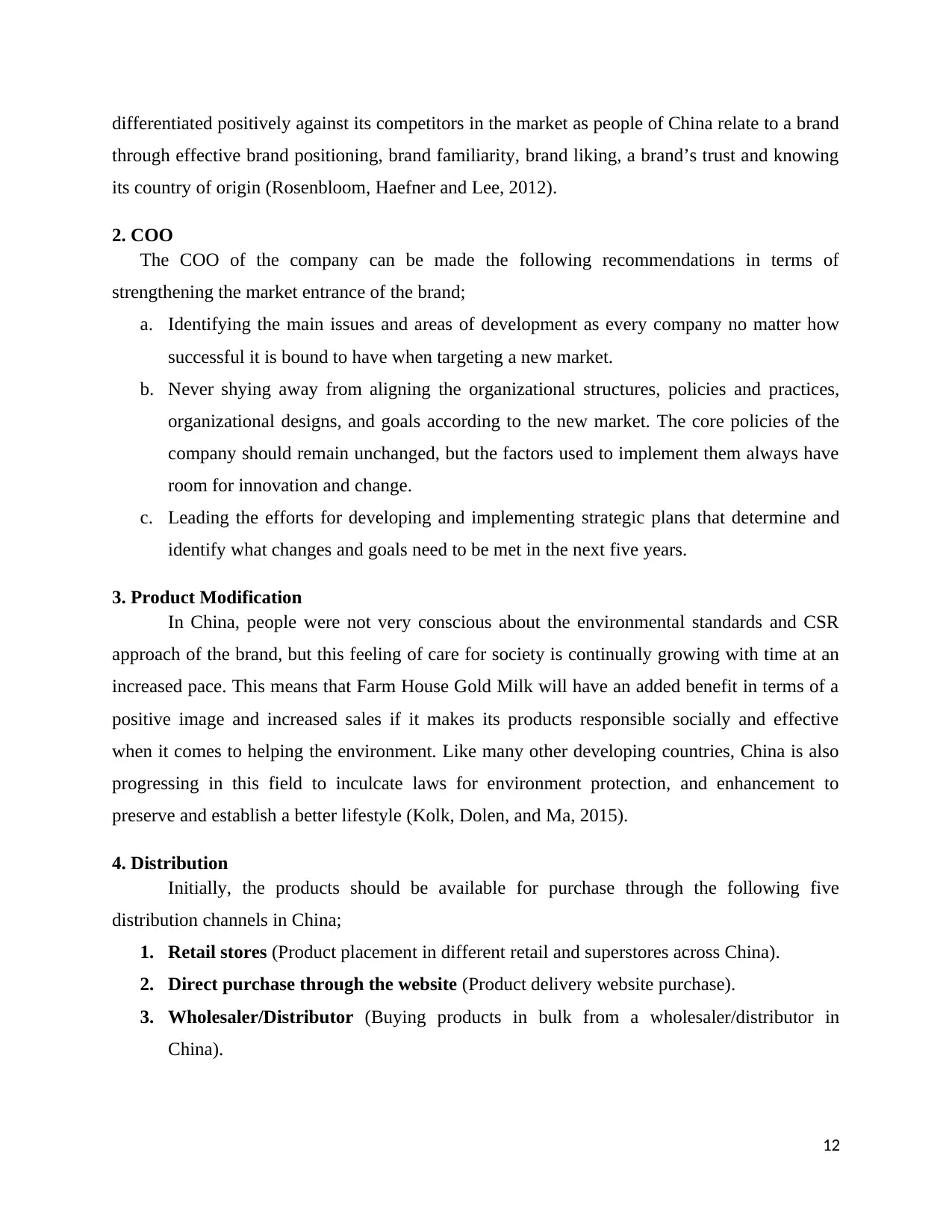
differentiated positively against its competitors in the market as people of China relate to a brand
through effective brand positioning, brand familiarity, brand liking, a brand’s trust and knowing
its country of origin (Rosenbloom, Haefner and Lee, 2012).
2. COO
The COO of the company can be made the following recommendations in terms of
strengthening the market entrance of the brand;
a. Identifying the main issues and areas of development as every company no matter how
successful it is bound to have when targeting a new market.
b. Never shying away from aligning the organizational structures, policies and practices,
organizational designs, and goals according to the new market. The core policies of the
company should remain unchanged, but the factors used to implement them always have
room for innovation and change.
c. Leading the efforts for developing and implementing strategic plans that determine and
identify what changes and goals need to be met in the next five years.
3. Product Modification
In China, people were not very conscious about the environmental standards and CSR
approach of the brand, but this feeling of care for society is continually growing with time at an
increased pace. This means that Farm House Gold Milk will have an added benefit in terms of a
positive image and increased sales if it makes its products responsible socially and effective
when it comes to helping the environment. Like many other developing countries, China is also
progressing in this field to inculcate laws for environment protection, and enhancement to
preserve and establish a better lifestyle (Kolk, Dolen, and Ma, 2015).
4. Distribution
Initially, the products should be available for purchase through the following five
distribution channels in China;
1. Retail stores (Product placement in different retail and superstores across China).
2. Direct purchase through the website (Product delivery website purchase).
3. Wholesaler/Distributor (Buying products in bulk from a wholesaler/distributor in
China).
12
through effective brand positioning, brand familiarity, brand liking, a brand’s trust and knowing
its country of origin (Rosenbloom, Haefner and Lee, 2012).
2. COO
The COO of the company can be made the following recommendations in terms of
strengthening the market entrance of the brand;
a. Identifying the main issues and areas of development as every company no matter how
successful it is bound to have when targeting a new market.
b. Never shying away from aligning the organizational structures, policies and practices,
organizational designs, and goals according to the new market. The core policies of the
company should remain unchanged, but the factors used to implement them always have
room for innovation and change.
c. Leading the efforts for developing and implementing strategic plans that determine and
identify what changes and goals need to be met in the next five years.
3. Product Modification
In China, people were not very conscious about the environmental standards and CSR
approach of the brand, but this feeling of care for society is continually growing with time at an
increased pace. This means that Farm House Gold Milk will have an added benefit in terms of a
positive image and increased sales if it makes its products responsible socially and effective
when it comes to helping the environment. Like many other developing countries, China is also
progressing in this field to inculcate laws for environment protection, and enhancement to
preserve and establish a better lifestyle (Kolk, Dolen, and Ma, 2015).
4. Distribution
Initially, the products should be available for purchase through the following five
distribution channels in China;
1. Retail stores (Product placement in different retail and superstores across China).
2. Direct purchase through the website (Product delivery website purchase).
3. Wholesaler/Distributor (Buying products in bulk from a wholesaler/distributor in
China).
12
⊘ This is a preview!⊘
Do you want full access?
Subscribe today to unlock all pages.

Trusted by 1+ million students worldwide
1 out of 17
Related Documents
Your All-in-One AI-Powered Toolkit for Academic Success.
+13062052269
info@desklib.com
Available 24*7 on WhatsApp / Email
![[object Object]](/_next/static/media/star-bottom.7253800d.svg)
Unlock your academic potential
Copyright © 2020–2025 A2Z Services. All Rights Reserved. Developed and managed by ZUCOL.





